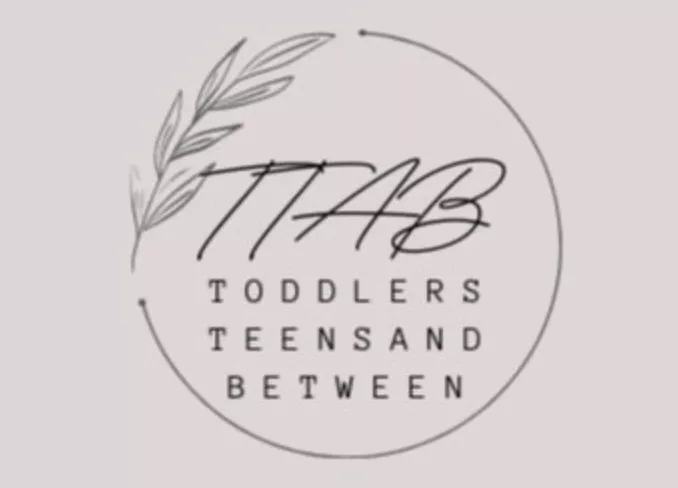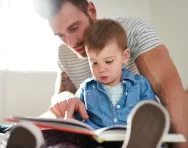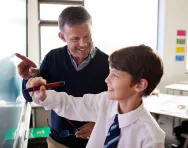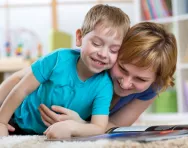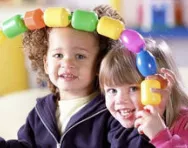Developing a wellbeing toolkit for your primary child

That’s why we asked children’s mental health and wellbeing experts, Gemma and Sophia from ToodlersTeensAndBetween, to share their insight and help parents and carers provide an environment for kids that will allow them to hone these emotional skills.
Emotional intelligence: labelling and empathy
Emotional intelligence is about understanding and managing your emotions. Recognising and labelling emotions is an important step towards strong emotional intelligence.
Both parent and child can use empathy and labelling as tools to regulate emotions and improve wellbeing. Take a moment to consider how your child might be feeling when their behaviour becomes challenging. Reflect back to them how they are feeling and give your little ones the emotional language to comprehend it.
For example, if they are crying and angry, label the emotion you can see in them: “I can see you’re feeling angry because you’re stomping around.” Then demonstrate empathy as a tool: “I understand why you feel like that. It’s difficult to have your toys taken away/turning off your device/leaving the park. I get it.”
Use the ‘child perspective’ to embed your empathic language: “It must be frustrating when mummy/daddy/carer says you can’t do something you want to do.” And try to demonstrate active listening, using your body as well as your language to show you’ve heard them and their emotion. Repeating back what they’ve said, making direct eye contact, nodding your head – all of these things show you are really listening.
Sometimes, this type of conversation may need to wait until your child has 'let off steam' or physically expressed their emotion (in a safe environment). They may not be in ‘listening mode’ if they are throwing toys etc. But try to have this conversation with them as soon as you feel they are ready to listen. You will probably find that, over time, they are ready to listen a little bit sooner.
This isn’t about solving the problem for them; it’s about hearing them. When parents keep in mind the difference between a solving discussion and an empathy discussion it can help to frame the chosen response. Consider: What is the learning opportunity for my little one in this situation and how can I teach it to them? What can I say to teach them to become independent, emotionally intelligent thinkers?
Emotional intelligence is not only about understanding your own emotions but also other people’s, so consider asking your child questions about how others might be feeling. If you hear a baby crying in a shop, perhaps ask them why they think the baby is crying. Can they list all the reasons? Why does the baby cry to express the emotion? When they get older, what might they do instead? You can create games and find activities online that help children understand and label their own emotions and emotions that they see in others.
Resilience: practising coping mechanisms
Demonstrating multiple coping techniques for your child is fundamental to help them develop their own resilience. Showing them breathing techniques like blowing the petals off the flower, blowing out the candles, following their fingers as they trace around the palm of their hand and box breathing along a rectangular shape are all brilliant ways for little ones to learn to self-soothe. You can find plenty of worksheets and special wellbeing apps for kids that teach breathing techniques.
Practising mindfulness techniques and how to be present can reduce feelings that are overwhelming, such as anxiety or stress. Counting to ten is a classic, as well as asking them to identify five things they can see, four things they can hear, three things they can touch, two things they can taste and one thing they can smell. It helps ground and centre little ones in the moment and becomes an early foundation for mindfulness. By demonstrating these techniques and taking part in the practice, you will also find yourself as a parent coping better with these difficult moments.
Confidence: being kind to yourself
Practise positive affirmations about their internal character in the mirror before bedtime together or in the morning and encourage them to repeat them back as this forms the basis for their internal voice. This will help programme their mind towards confidence and self-compassion, rather than self-doubt and negativity. Maybe ask them three things they like about themselves and tell them three things you like about yourself. This is easiest to do when they are younger, as once they hit high school they may feel too silly or embarrassed to start this healthy routine.
Have a mantra about continuing to try when things are hard. We often suggest a mantra like: ‘I can, I will’ or ‘I can’t do it yet, but I will try!’
Finally, adapt your language to focus away from what they can’t do, and instead onto what they should and could do. As they get older, you can introduce a journal and writing as a release coping method.
Consider the ways in which you, as the parent, speak about yourself and others. It’s easy to overlook the ways you demonstrate self-care, confidence and a can-do attitude in front of your kids.
Resilience: exposure to difficult situations
The very best way to develop resilience in our children is through exposure to different environments, activities and circumstances. The important thing to focus on is how we, as parents or carers, handle those moments.
You don’t need to play the problem down and you don’t need to fix it, as ultimately you want them to believe they have the skills to get through the ups and downs of life. This is what truly builds long-lasting confidence in your child; the knowledge that they can handle any situation.
Let’s take the common example of changing friendships during a transition to a new school. Your child will be noticeably sad that things are changing and that their friendships have shifted. You can empathise by saying: “That does sound hard and it’s a big change. You were closer with your friends before and now you’re not so friendly with them and that doesn’t feel good.”
Then you offer a compassionate perspective by saying: “Friends are sometimes in your life for a reason, season or a lifetime and it’s true that friends do come in and out of our lives. That is okay and it is also sad.”
Develop this by encouraging further coping mechanisms: “If you like, I can sit with you while you deal with that sadness of losing a friendship. We can talk about the loss and cherish some of your lovely memories. We can also discuss what is exciting and new about developing new friendships too.”
You’re not fixing their situation, but providing them space to sit with their feelings, reflect and learn how to cope. Parents and carers can never explicitly teach kids to suddenly gain the skill of resilience, so the more unique and varied situations children go through and knowing how to manage, the better!
Little ones adore predictability and routine, but doing things differently, learning to adapt, accepting mistakes and change and seeing these as learning opportunities is ideal and, ultimately, builds their resilience and internal growth mindset.
More help and support
ToddlersTeensAndBetween (TTAB) support parents with the wellbeing and behaviour of their toddlers, teens and between. Gemma and Sophia have over 18 combined years working as primary and secondary school educators with expertise in children and adolescent behaviour and mental health support (and they are both parents themselves!).

Give your child a headstart
- FREE articles & expert information
- FREE resources & activities
- FREE homework help
